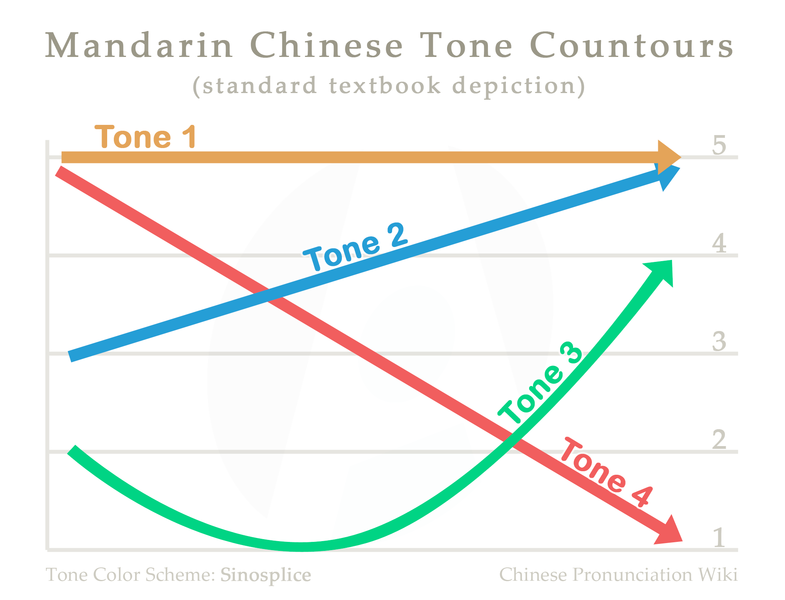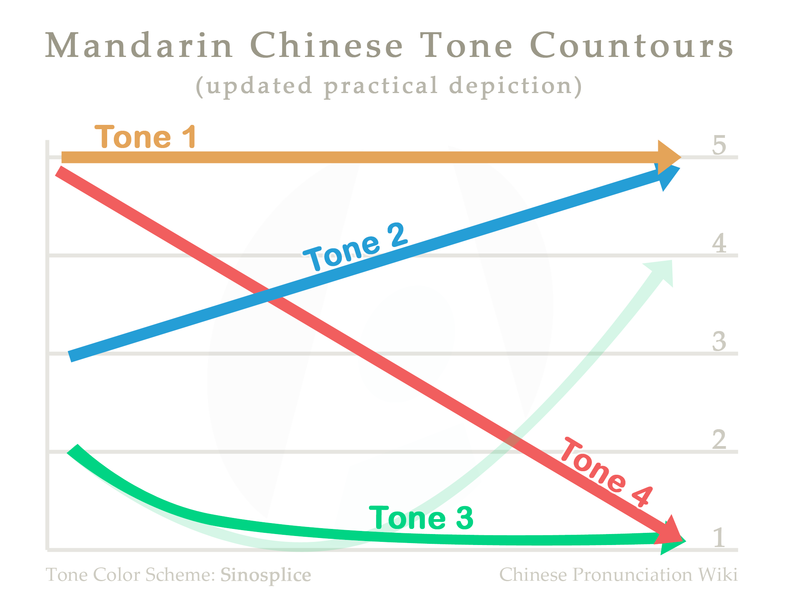Difference between revisions of "Four tones"
| Line 10: | Line 10: | ||
[[File:Tone-Contours Sinosplice.png||785px|thumb|center]] | [[File:Tone-Contours Sinosplice.png||785px|thumb|center]] | ||
| − | |||
| − | |||
| − | |||
| − | |||
| − | |||
| − | |||
== First Tone == | == First Tone == | ||
| Line 36: | Line 30: | ||
This tone has its [[neutral tone|own page]], so we won't cover it here. Just keep it short and light. Don't emphasize it. | This tone has its [[neutral tone|own page]], so we won't cover it here. Just keep it short and light. Don't emphasize it. | ||
| + | |||
| + | == Updated Tone Diagram == | ||
| + | |||
| + | These days, more and more Chinese learning resources are representing the 3rd tone in a different way: as a '''low tone''' (which doesn't actually rise very much, but also isn't as flat as the 1st tone). This is because 3rd tone is normally only pronounced in its full "rising and falling" form when it is pronounced in isolation (e.g. as a single, one-syllable word). Most of the time 3rd tone precedes other tones, and is pronounced as a "half-third tone" which doesn't rise again after it goes low. | ||
| + | |||
| + | [[File:Tone-Contours low3rd Sinosplice.png||785px|thumb|center]] | ||
| + | |||
| + | Remember: the key thing about third tone is that it is '''low'''. Focus on that! | ||
== Sources and further reading == | == Sources and further reading == | ||
Revision as of 07:00, 15 May 2015
| This article is a stub. Editors can help the Chinese Pronunciation Wiki by expanding it. |
-
Level
- Also known as: 四声 (sìshēng).
One of the first concepts you need to learn when tackling Mandarin Chinese is tones. You'll often hear that there are four main tones, although there is also a "neutral tone," so you sometimes hear it said that there are five.
Contents
Tone Diagram
Below is the standard tone diagram you will see in most textbooks and traditional Chinese courses. The numbers 1-5 refer to relative pitch differences; they're not absolute values, and will vary from speaker to speaker.
First Tone
The first tone is high and flat. Some feel that it sounds "robotic" because it is monotone. The first tone can also be a bit longer in duration compared to the other three tones. (This helps make it more obvious to the listener that the tone is flat.)
Second Tone
The second tone is rising. Some feel that it sounds like you're asking a question, and if that helps you make the tone properly in the beginning, do it!
Third Tone
The third tone is low. It is often called the "falling-rising" tone or the "dipping" tone, but it's more important that the tone be super low than that it rises. Keep it low!
Fourth Tone
The fourth tone is falling. To many learners, it sounds angry. Several 4th tones in a row might sound like an angry staccato to you. Don't be afraid to emphasize the 4th tone by making it sound a little angry. The 4th tone also tends to be shorter in duration than the other three tones.
Neutral Tone
This tone has its own page, so we won't cover it here. Just keep it short and light. Don't emphasize it.
Updated Tone Diagram
These days, more and more Chinese learning resources are representing the 3rd tone in a different way: as a low tone (which doesn't actually rise very much, but also isn't as flat as the 1st tone). This is because 3rd tone is normally only pronounced in its full "rising and falling" form when it is pronounced in isolation (e.g. as a single, one-syllable word). Most of the time 3rd tone precedes other tones, and is pronounced as a "half-third tone" which doesn't rise again after it goes low.
Remember: the key thing about third tone is that it is low. Focus on that!
Sources and further reading
Websites
- Wikipedia: Standard Chinese phonology: Tones
- Wikipedia: Mandarin Chinese: Tones
- Wikipedia: Four tones (Chinese)
- Sinosplice: Toward Better Tones in Natural Speech
- Hacking Chinese: Tones are more important than you think
- Sinosplice: Kaiser’s “Dude System” of Tones
Videos
- YouTube: [The Most Effective Way to Learn Mandarin Tones - Tone Pairs - Google Hangout with Yangyang] (00:00-08:15)



